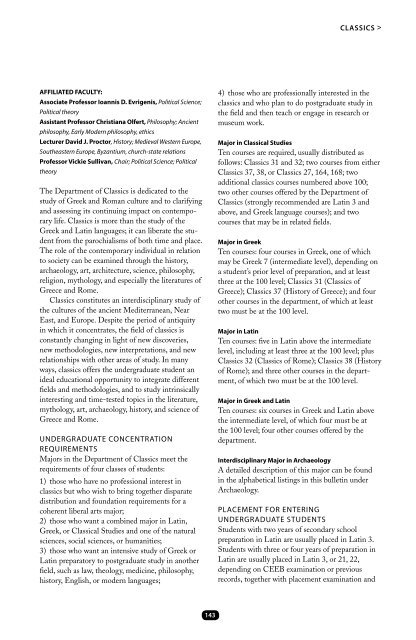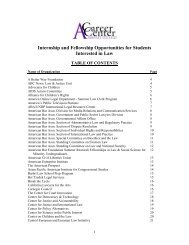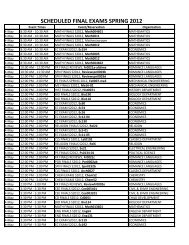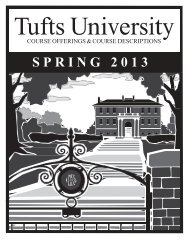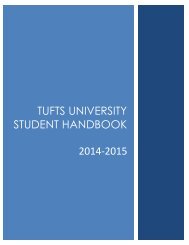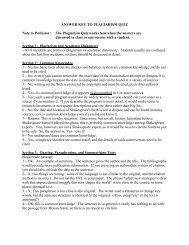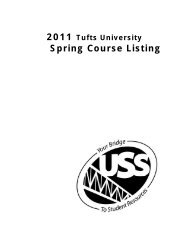2013â2014 The Bulletin - USS at Tufts - Tufts University
2013â2014 The Bulletin - USS at Tufts - Tufts University
2013â2014 The Bulletin - USS at Tufts - Tufts University
Create successful ePaper yourself
Turn your PDF publications into a flip-book with our unique Google optimized e-Paper software.
Classics ><br />
AFFILIATED FACULTY:<br />
Associ<strong>at</strong>e Professor Ioannis D. Evrigenis, Political Science;<br />
Political theory<br />
Assistant Professor Christiana Olfert, Philosophy; Ancient<br />
philosophy, Early Modern philosophy, ethics<br />
Lecturer David J. Proctor, History; Medieval Western Europe,<br />
Southeastern Europe, Byzantium, church-st<strong>at</strong>e rel<strong>at</strong>ions<br />
Professor Vickie Sullivan, Chair; Political Science; Political<br />
theory<br />
<strong>The</strong> Department of Classics is dedic<strong>at</strong>ed to the<br />
study of Greek and Roman culture and to clarifying<br />
and assessing its continuing impact on contemporary<br />
life. Classics is more than the study of the<br />
Greek and L<strong>at</strong>in languages; it can liber<strong>at</strong>e the student<br />
from the parochialisms of both time and place.<br />
<strong>The</strong> role of the contemporary individual in rel<strong>at</strong>ion<br />
to society can be examined through the history,<br />
archaeology, art, architecture, science, philosophy,<br />
religion, mythology, and especially the liter<strong>at</strong>ures of<br />
Greece and Rome.<br />
Classics constitutes an interdisciplinary study of<br />
the cultures of the ancient Mediterranean, Near<br />
East, and Europe. Despite the period of antiquity<br />
in which it concentr<strong>at</strong>es, the field of classics is<br />
constantly changing in light of new discoveries,<br />
new methodologies, new interpret<strong>at</strong>ions, and new<br />
rel<strong>at</strong>ionships with other areas of study. In many<br />
ways, classics offers the undergradu<strong>at</strong>e student an<br />
ideal educ<strong>at</strong>ional opportunity to integr<strong>at</strong>e different<br />
fields and methodologies, and to study intrinsically<br />
interesting and time-tested topics in the liter<strong>at</strong>ure,<br />
mythology, art, archaeology, history, and science of<br />
Greece and Rome.<br />
UNDERGRADUATE concentrATION<br />
REQUIREMENTS<br />
Majors in the Department of Classics meet the<br />
requirements of four classes of students:<br />
1) those who have no professional interest in<br />
classics but who wish to bring together dispar<strong>at</strong>e<br />
distribution and found<strong>at</strong>ion requirements for a<br />
coherent liberal arts major;<br />
2) those who want a combined major in L<strong>at</strong>in,<br />
Greek, or Classical Studies and one of the n<strong>at</strong>ural<br />
sciences, social sciences, or humanities;<br />
3) those who want an intensive study of Greek or<br />
L<strong>at</strong>in prepar<strong>at</strong>ory to postgradu<strong>at</strong>e study in another<br />
field, such as law, theology, medicine, philosophy,<br />
history, English, or modern languages;<br />
4) those who are professionally interested in the<br />
classics and who plan to do postgradu<strong>at</strong>e study in<br />
the field and then teach or engage in research or<br />
museum work.<br />
Major in Classical Studies<br />
Ten courses are required, usually distributed as<br />
follows: Classics 31 and 32; two courses from either<br />
Classics 37, 38, or Classics 27, 164, 168; two<br />
additional classics courses numbered above 100;<br />
two other courses offered by the Department of<br />
Classics (strongly recommended are L<strong>at</strong>in 3 and<br />
above, and Greek language courses); and two<br />
courses th<strong>at</strong> may be in rel<strong>at</strong>ed fields.<br />
Major in Greek<br />
Ten courses: four courses in Greek, one of which<br />
may be Greek 7 (intermedi<strong>at</strong>e level), depending on<br />
a student’s prior level of prepar<strong>at</strong>ion, and <strong>at</strong> least<br />
three <strong>at</strong> the 100 level; Classics 31 (Classics of<br />
Greece); Classics 37 (History of Greece); and four<br />
other courses in the department, of which <strong>at</strong> least<br />
two must be <strong>at</strong> the 100 level.<br />
Major in L<strong>at</strong>in<br />
Ten courses: five in L<strong>at</strong>in above the intermedi<strong>at</strong>e<br />
level, including <strong>at</strong> least three <strong>at</strong> the 100 level; plus<br />
Classics 32 (Classics of Rome); Classics 38 (History<br />
of Rome); and three other courses in the department,<br />
of which two must be <strong>at</strong> the 100 level.<br />
Major in Greek and L<strong>at</strong>in<br />
Ten courses: six courses in Greek and L<strong>at</strong>in above<br />
the intermedi<strong>at</strong>e level, of which four must be <strong>at</strong><br />
the 100 level; four other courses offered by the<br />
department.<br />
Interdisciplinary Major in Archaeology<br />
A detailed description of this major can be found<br />
in the alphabetical listings in this bulletin under<br />
Archaeology.<br />
PLACEMENT FOR ENTERING<br />
UNDERGRADUATE STUDENTS<br />
Students with two years of secondary school<br />
prepar<strong>at</strong>ion in L<strong>at</strong>in are usually placed in L<strong>at</strong>in 3.<br />
Students with three or four years of prepar<strong>at</strong>ion in<br />
L<strong>at</strong>in are usually placed in L<strong>at</strong>in 3, or 21, 22,<br />
depending on CEEB examin<strong>at</strong>ion or previous<br />
records, together with placement examin<strong>at</strong>ion and<br />
143


